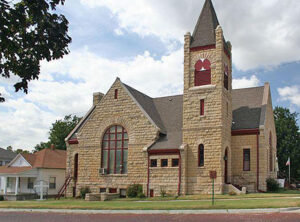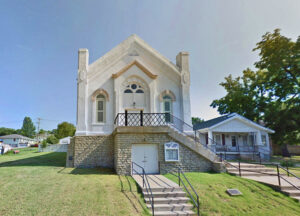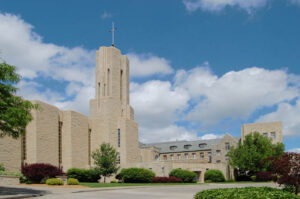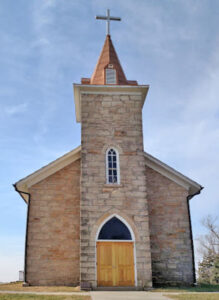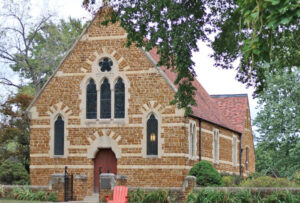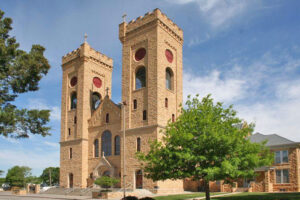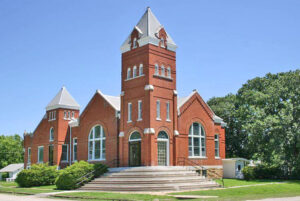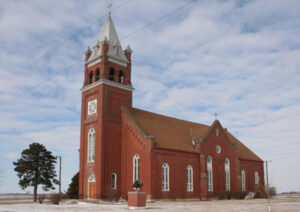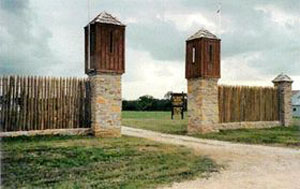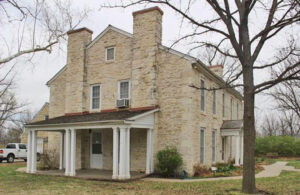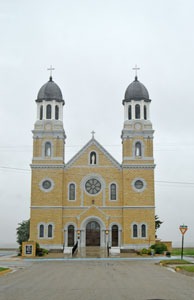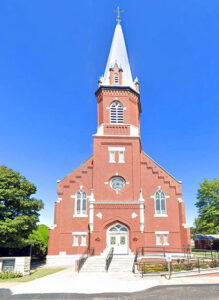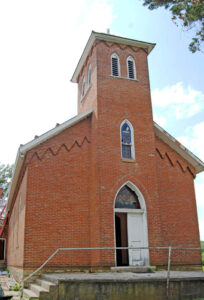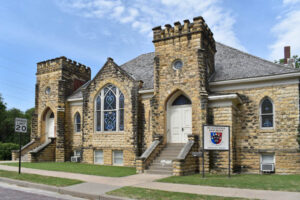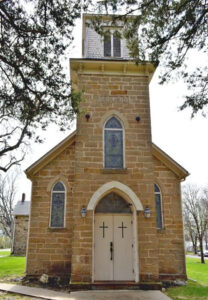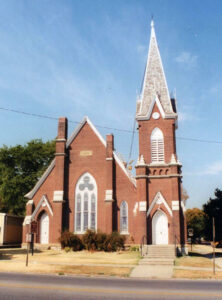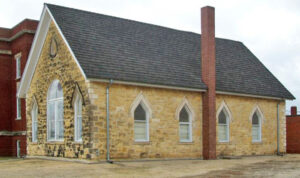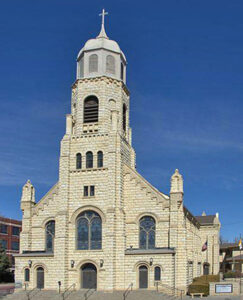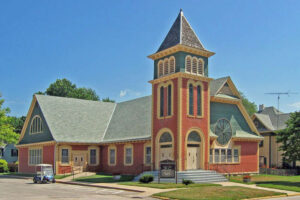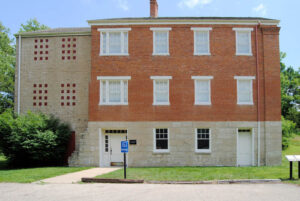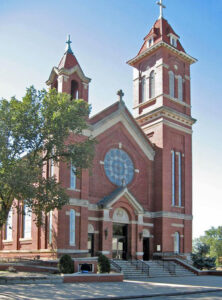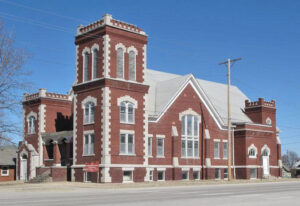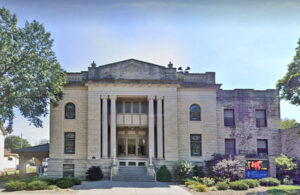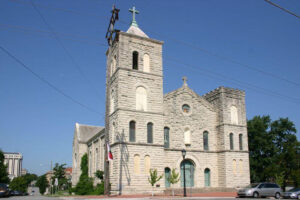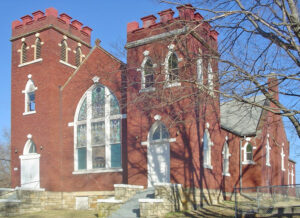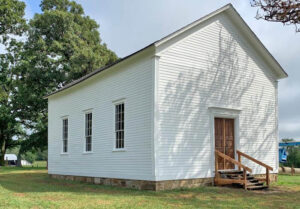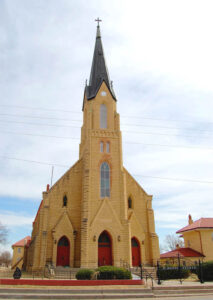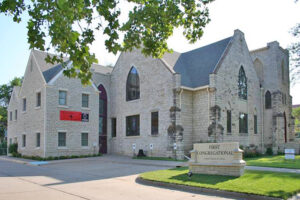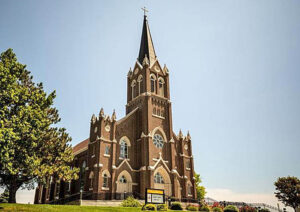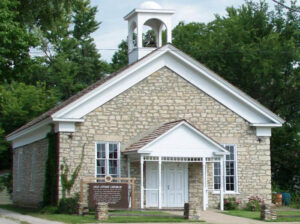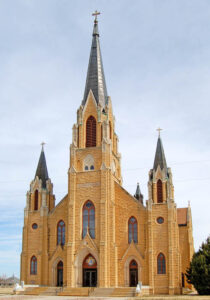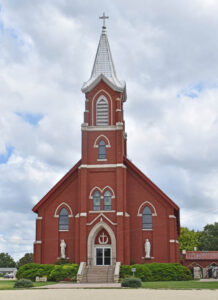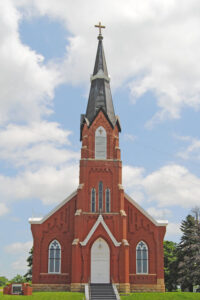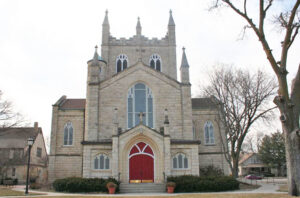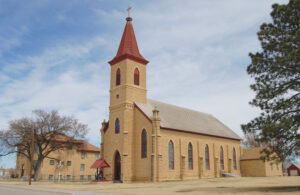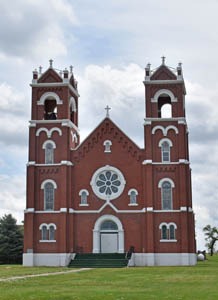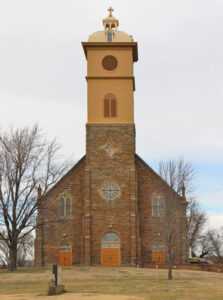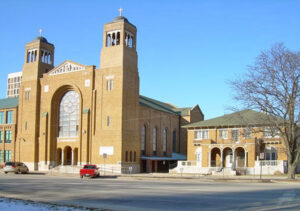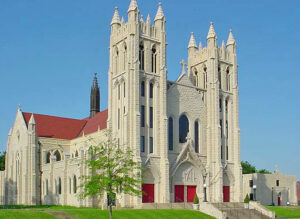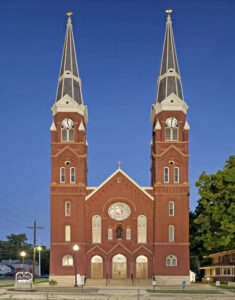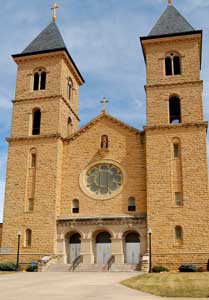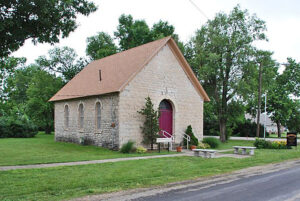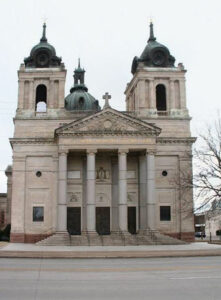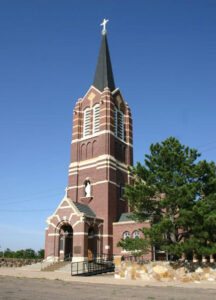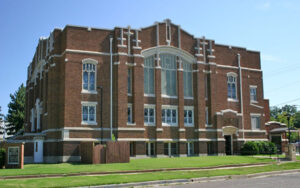The first churches in what is now the State of Kansas were established while it was still an unorganized territory. Churches have long been a focal point in communities for worship and social needs. Today, Kansas has numerous historic and beautiful church buildings.
~~
Arkansas City – The Pilgrim Congregational Church, one of Arkansas City’s most impressive historic buildings, was built between 1891 and 1893. This one-and-a-half-story sandstone building was designed in the Richardsonian Romanesque style with semi-circular Roman arches over windows and entrances, rough-faced masonry walls, towers, and asymmetrical façades. Its roof has five gables; the gable ends have parapets with metal caps and limestone cornices. The bell tower is 78 feet tall. In 1949, it became home to the Nazarene Church, and in 2002, it became the Vinelife Family Church. One of the city’s oldest churches is at 101 North 3rd Street in Arkansas City. It was listed on the National Register of Historic Places in June 2005.
Atchison – Campbell Chapel African Methodist Episcopal Church, located at 715 Atchison Street, was built by John Thompson in 1878. The one-story, front-gabled structure was built in the Richardsonian Romanesque/Romanesque Revival style with a gable roof. The rectangular stucco and brick building stands on an above-grade foundation and is situated on a bluff overlooking downtown Atchison. It was listed on the National Register of Historic Places in January 2023.
Atchison – Mount Saint Scholastica Convent at 801 South 8th Street was built in 1904. The Benedictine Sisters of Mount St. Scholastica have been in Atchison since 1863. It is a four-story U-shaped brick building with a flat roof and parapet, designed in the Collegiate Gothic style. Its chapel is rich with beautiful marble, a large rose window, and stained-glass windows honoring seven martyred women saints. The interior of the Choir Chapel, which has facing choir stalls and stained-glass windows retelling the life of St. Benedict, has a vaulted ceiling and stained-glass windows. It was listed on the National Register of Historic Places in April 1972.
Atchison – St. Benedict’s Abbey Church is the local center of the Catholic Order of St. Benedict, a global religious community founded in 1857 to educate the sons of German settlers in Kansas Territory. The first Monks of the Catholic Order of St Benedict arrived in Atchison in 1858. St. Benedict’s Abbey Church was built around the earlier Saint Peter and Saint Paul Church, which held its first Mass on December 25, 1858. The cornerstone was laid on August 26, 1866. The Abbey was built in 1928 and is the home of the monks, providing faculty and administration for Benedictine College. Before 1957, St. Benedict’s was the Abbey Church, but it was replaced by the present Abbey Church, completed in 1957, and serves the students of Benedictine College. Designed in the Modern/Modern Movement style, the L-shaped stone building is 270 feet long and 118 feet wide with a flat roof and parapet. St. Benedict’s church is at the southwest corner of Benedictine College and is connected to St. Benedict’s Abbey. It is located at 1020 North 2nd Street.
Atchison – St. Patrick’s Catholic Church, a few miles south of Atchison, Kansas, is a lovely old stone church. German and Irish immigrants established St. Patrick’s parish in 1857, and a wooden church was completed in 1859. The wooden structure was destroyed by a tornado in 1861 and replaced with a 20-foot by 30-foot log building. The present church building was completed in 1866. It was listed on the National Register of Historic Places in 1998.
Baldwin City – Clarice L. Osborne Memorial Chapel at Baker University in Baldwin City was initially constructed in Sproxton, England, in 1864 and was the home to its Methodist congregation for 124 years. After several years of disuse, it was acquired by Baker University, dismantled, and shipped to Baldwin City, where it was reassembled. Lady Margaret Thatcher assisted in the dedication because her father, Alfred, was a lay preacher who occasionally preached at the Sproxton chapel, with his daughter, Margaret, in attendance. Osborne Memorial Chapel at Baker University.
Beloit – St. John The Baptist Catholic Church, at 701 East Court Street, was built in the Richardsonian Romanesque/Romanesque Revival by Joseph Marshal in 1904. It is believed that the first Catholic Mass was offered in Beloit in 1871. By 1876, Mass was being offered somewhat regularly by visiting mission priests, and Bishop Louis M. Fink blessed the Catholic Cemetery in September of that year. The first resident priest in Beloit, Father John Timphaus, was appointed in 1877 and served between 25 and 30 families. Father Timphaus soon found that the second-story hall where Mass was being held was inadequate for his growing congregation. The first Catholic Church in Beloit was completed in 1878. It was followed by the opening of a parochial school for grades one through eight in the fall of 1879, staffed with one teacher and 15 students. The two-story stone building has a cross-gable roof. It was listed on the National Register of Historic Places in April 1975.
Burr Oak – The United Methodist Church on the northeast corner of Pennsylvania and Washington Streets in Burr Oak, Kansas. The one-and-a-half-story red brick building was designed in the Romanesque/Romanesque Revival style by architect J.C. Holland and built by M.E. Brady in 1912. It is a two-story, red brick and limestone structure with a hipped roof. It was listed on the National Register of Historic Places in November 2007. It remained a United Methodist Church until June 20, 2023, but left the denomination to combine with other community churches.
Bendena – St. Benedict’s Church in Doniphan County was designed in the High Victorian Gothic style and completed in 1903. It was built on the same limestone block foundation as the 1895 church, which was destroyed by a tornado. The rectangular, one-and-a-half-story building features a red brick exterior, a front-facing gable roof, and a tall bell tower with an arched doorway leading into the church. Each elevation contains six stained glass windows separated by false buttresses. The property also has a Garage/Carriage House, an education hall, and a cemetery. It was listed on the National Register of Historic Places in April 1998. It is located at 684 St. Benedict’s Road, five miles southwest of Bendena.
Centerville – St. Philippine Duchesne Historical and Memorial Park was the location of St. Mary’s Mission, also known as Sugar Creek Mission. It was established in 1838 by the United States government as a destination for the forced removal of nearly 900 Potawatomi Indians from Michigan and northern Indiana on a march known as “The Trail of Death.” Rose Philippine Duchesne was a Catholic sister who ministered to the Potawatomi people. She was beatified in 1940 and canonized in 1988.
Concordia – The Nazareth Convent and Academy is a four-story, irregularly shaped red brick building at 1300 Washington Street. It was designed in the Richardsonian Romanesque/Romanesque Revival style and was built by Wilson Hunt from 1898 to 1903. A chapel was added in 1907-1908, and a blond brick addition was added in 1968-1970. In 1884, the Reverend Joseph Perrier invited the Sisters of St. Joseph to come to Concordia to open a school in the Catholic Parish. Mother Stanislaus Leary, superior, and five sisters answered the invitation and established the Nazareth Motherhouse and Academy in a new building next to the church. It was the Cathedral for the Diocese of Concordia from 1887 until the Diocesan See was moved to Salina in 1945. The building is the official Motherhouse and Home for the 160 Sisters of St. Joseph of Concordia. It was listed on the National Register of Historic Places in July 1977.
Council Grove – The Kaw Methodist Mission, located at 500 North Mission Street, was built in 1851. Located 1,650 feet north of the Santa Fe Trail, it was initially built as a boarding school for Kaw children. It was the westernmost mission structure built in Kansas. After serving as a school, it became a private residence until 1951, when the State of Kansas purchased it for use as a museum and interpretive center. Designed in the Federal style, the two-story rectangular stone building has eight rooms, four limestone gable-end chimneys, and a wood shingle roof. The site also has a non-period stone garage and a relocated Kaw house. It became a state historic site in 1951 and was listed on the National Register of Historic Places in March 1977.
Damar – St. Joseph’s Catholic Church, located at 105 North Oak Street, was built from 1912 to 1917 to replace an earlier wood-frame structure. It was designed in the Richardsonian Romanesque/Romanesque Revival by Henry W. Brinkman of Emporia, Kansas, and built by Frank K. Rothengerger of Osborne. The one-and-a-half-story rectangular building was constructed of native limestone, with symmetrical bell towers with copper domed roofs. St. Joseph’s Catholic Church is open to visitors seven days a week. It was listed on the National Register of Historic Places in November 2005.
Danville – Immaculate Conception Catholic Church was constructed from 1904 to 1907, replacing the St. Rose of Lima church, which had been built in 1887. The Gothic-Romanesque church replaced the original. After a new pastor, Father P.J. Maloney, was appointed to the parish in 1902, the congregation quickly grew, requiring a larger church. The new church building was dedicated on November 21, 1907. The Gothic-Romanesque church has a 126-foot-tall bell tower. As the local population shrank more recently, Immaculate Conception was merged with catholic churches in the communities of Harper and Anthony to create the St. Joan of Arc parish. It is located at 102 Ashman Street on the west side of Danville, Kansas.
Doniphan – St. John the Baptist Oratory has served the unincorporated community of Doniphan, Kansas, for over 150 years. Doniphan is a ghost town today. Part of the present brick building was built in 1867, though the structure was enlarged in 1891. The stained glass windows were added in 1892. The Catholic Church has been restored and continues to be utilized for special masses such as weddings and funerals. The Brenner Vineyards Historic District was placed on the National Register of Historic Places in 2005, which includes 4.9 acres, the St. John’s Catholic Church, a two-story winery building, a barn, a corncrib and pump-house, a smokehouse, and the ruins of Adam Brenner’s house and winery. A still-utilized cemetery sits nearby. A few residents still live in the area. It is located at 209 Lone Star Road in Doniphan County, Kansas.
Ellis – Wise and Jacobs built the Ellis Congregational Church at 720 Washington Street between 1907 and 1908. The First Congregational Church, founded in Ellis in 1873, is believed to be the first organized congregation in the town. Early services were held in the Ellis House, the town’s first schoolhouse. The one-and-a-half-story rectangular stone building was designed in the Gothic Revival style, with a hip roof and lower cross gables. The church closed in 1971, and a few years later, the Ellis Arts and Historical Society helped preserve the historic building. Afterward, it was made available for public use, with the chapel hosting occasional weddings and the lower level hosting local meetings, meals, and receptions. In 1991, it became the headquarters and museum of the Bukovina Society. In 1886, the first Bukovina Germans arrived in Ellis, Kansas, and served as scouts for a larger group that settled there in 1887. The building was listed on the National Register of Historic Places in March 2000.
Eudora – The Holy Family Catholic Church, located at 911 East 9th Street, was built of stone in the Gothic Revival style in 1864. The original building, measuring 20 feet by 48 feet, was built for and by families of the German Church of the Holy Family and was officially organized on October 1, 1864. The one-story L-shaped building with a gable roof was built with sandstone from a local quarry. In 1896, parish men also hauled stone from a large sandstone quarry three miles southwest of town to complete a 26-foot by 20-foot addition facing north with a vestibule, 60-foot steeple, and a five-foot cross. In about 1942, genuine stained-glass windows were installed, representing the Holy Family, St. Lawrence, and a harp. In the mid-1950s, a tornado struck the church, damaging the steeple. It was then decided to remove the steeple permanently and place the cross on top of the bell tower. The church was used until 1963, when a new church and school were built at 820 Birch Street. At that time, the bells were removed from the old church and installed atop a large steel tower at the new church. In 1981, the restoration included vine removal, stone replacement, backlit stained-glass windows, carpeting, floor repair, pew furnishings, and stained woodwork. The original Holy Family Catholic Church now opens for special occasions, such as the Adoration and Prayer Chapel and Christmas carol programs. It was listed on the National Register of Historic Places in October 2020.
Fort Scott – The First Congregational Church, located at 502 South National Street, was built in 1873 by Chumlea & Mikesell. It was built in brick to replace the original First Congregational Church, which was made of wood and burned down in 1872. Also known as the Brethren Church or Old Congregational Church, the one-story, rectangular brick church was designed in the Gothic Revival style, featuring a steeply pitched gable roof, pointed arch windows, a vaulted ceiling, and a tall steeple. It was listed on the National Register of Historic Places in March 2005
Hays – The First Presbyterian Church, located at 100 West 7th Street, was built in 1879. The one-and-a-half-story stone building was designed in the Vernacular style with a cross-gable roof. It is the oldest existing church building in Ellis County. The congregation grew over the years, and from 1911 to 1913, a tower and an east wing were added using stone from an Episcopal Church That Was torn down in nearby Victoria. In 1926, a much larger formal classical red brick building was added to the east end of the old church. Both buildings were used until 1975, when a different church was built. The 1879 and 1926 churches are now the home of the Ellis County Historical Society Museum. The stone church was listed on the National Register of Historic Places in March 1973. It is also included in the Chestnut Street Historic District, listed on the National Register in September 2008.
Hays – St. Joseph’s Catholic Church, located at 217 West 13th Street, was built in 1904. The St. Joseph’s Catholic Parish traces its roots to the mid-1870s when German Catholics arrived in Ellis County. The Romanesque Revival style church building and a 1907 Parochial School were designed by the Topeka architect Joseph Marshall, who earned a reputation for designing several religious, educational, and institutional buildings. The two-and-a-half-story church was designed in the Richardsonian Romanesque/Romanesque Revival style, featuring a gabled nave defined by a tiered tower that rises from the center of the front elevation and corner buttresses with massive spires. Round-arched openings and frame-stained-glass windows adorn the stone building. It was listed on the National Register of Historic Places in November 2008.
Highland – The Highland Christian Church, located at 102 East Main Street, was constructed by prominent local builder Ely Saunders in 1904. Touted in the Highland Vidette as “the most handsome in Highland,” it was designed in a variation of the popular Shingle style at the time. The two-story, L-shaped building was built of brick and wood shingles, featuring a gable roof and a three-story, square steeple. It was listed on the National Register of Historic Places in April 2007. It was deemed “significant as an example of the Shingle Style adapted to a church building.”
Highland – The Iowa, Sac, and Fox Presbyterian Mission, located at 1737 Elgin Road near Highland, Kansas, was built in 1846. A belfry tops the rectangular three-story stone and brick building with a side gable roof. The mission was used as a church and school by the Native Americans in the area between 1845 and 1863. On average, about 40 students lived at the mission. The mission’s main goal was to dissuade tribal culture and transform the Indians into self-sufficient farmers with Christian beliefs. From the early 1840s to 1865, the Oregon Trail was active, with the mission acting as a lucrative destination due to its position on the trail. The tribes benefited by charging a toll over their bridge, but the travelers who came through brought diseases such as smallpox and cholera, causing the tribes to move away from the mission. It was declared a state historic site in 1963 and was listed on the National Register of Historic Places in December 1970. It serves as a museum today. It is 1.5 miles. East of Highland on U.S. Highway 36 and .2 Mi. North on K-136.
Hutchinson – St. Teresa’s Catholic Church, at 211 E 5th Avenue, is a large two-story brick Romanesque Revival church built in 1909 by the H.I. Ellis Construction Company. The Santa Fe Railroad was credited with bringing enough Irish Catholic workers to Reno County to establish a mission in the living room of Mr. Foley, who lived about 2 1/2 miles north of the present Yoder Bridge. Father Paul Ponziglioni came regularly on horseback to serve the group. By 1876, the Church was meeting in the courthouse. C.C. Hutchinson gave the Catholics a free lot on the southwest of 2nd and Maple Streets, and a small wooden church was soon constructed. In January 1887, this building was lit with electric lights, and it was the first church in the city to enjoy this luxury. Before the turn of the century, land was bought on the southeast corner of 5th and Poplar Streets, and the original wooden Church building was moved to the site. A Catholic School was begun in a two-story house at 210 E 4th in 1902. Construction on the red brick school building at 215 W 5th began in 1904, and the first classes were held there in 1906. Built in the Richardsonian Romanesque/Romanesque Revival style, asymmetrical towers measuring 70 and 115 feet flanked the central gable form. It was listed on the National Register of Historic Places in April 1994.
Independence – The First Congregational Church, located at 400 North 9th Street, is the second house of worship for the First Congregational Church. The first building was located at the southwest corner of 8th and Myrtle Streets, where the former U.S. Post Office now stands as a museum. It was designed in the Eclectic style, featuring elements such as crenelated towers and flat Gothic arch windows. The two-and-a-half-story rectangular brick building with a gable roof was built between 1910 and 1911. It was listed on the National Register of Historic Places in October 2014.
Junction City – The First Presbyterian Church, located at 113 West 5th Street, was built in 1920-1921 by Clarence Johnson. The Presbyterian congregation was formed in 1868 with 11 members. The congregation met in various places until a church was constructed. Services were first held on Christmas Eve, 1870. The church served the community and Fort Riley in its historic early years. This building served well until World War I, when the need for a larger building was seen. In 1920, the first church building was torn down, and construction on the new one began. The three-story rectangular stone building has a flat roof with a parapet. It was listed on the National Register of Historic Places in October 2021.
Kansas City – St. Mary’s Catholic Church, located at 800 North 5th Street, was built in 1903 in the Richardsonian Romanesque and Romanesque Revival styles. The two-story stone church has a cross-gable roof. St. Mary’s is the oldest Catholic parish in Kansas City, established in 1858 as the Mother of God parish at Ninth and Ann Avenue. A second church was built in 1865. The present church was begun in 1890 and dedicated on June 21, 1903.
Lawrence – The Plymouth Congregational Church, located at 925 Vermont Street, was built between 1868 and 1870. The congregation dates back to Lawrence’s earliest pre-Civil War days. The first church service was held on October 1, 1854, in a mud brick boarding house, just weeks after the first groups of New England settlers arrived. It was designed by prominent Kansas architect John G. Haskell in the Richardsonian Romanesque/Romanesque Revival style, and church services have occurred in this building continuously since it was completed in May 1870. The North Church addition was erected in 1957, and the South Church addition was erected in 2001. The two-story brick building with its gable roof was listed on the National Register of Historic Places in September 2009.
Lawrence – St. Luke African Methodist Episcopal Church, located at 900 New York Street, was built in 1910 by J.T. Constant. The irregularly shaped, two-story brick building was designed in the Late Gothic Revival style, featuring an intersecting gable roof. It was listed on the National Register of Historic Places in November 2005.
Leavenworth – The Chapel of Veterans, located at 4101 North 4th Street, Fort Leavenworth, Kansas, was inspired by a Gothic chapel in England. The two-story post chapel was designed in the Gothic Revival style, made of sandstone and brick, in 1893. The tower has eleven tubular bells and three gargoyles. The lower level is the Catholic chapel called the Holy Ghost Chapel, and the upper level is the Protestant chapel called the Immanuel Chapel. The building was listed on the National Register of Historic Places as part of the Fort Leavenworth Historic District in April 1999.
Leavenworth County – Little Stranger Church is believed to be the oldest wood-frame house of worship in the state of Kansas. The first service was held on May 12, 1868, although the congregation had begun meeting ten years earlier in a log schoolhouse on Little Stranger Creek. The congregation members built the church with lumber sawn from cottonwood trees at a nearby lumberyard. The one-story, rectangular wood-frame building was designed in the Vernacular style with exceptionally tall ceilings. An outhouse stands on the north side of the building, and a cemetery surrounds the church on its west and north sides. Vacant and unused today, it is located at 17062 Stranger Road, about six miles southwest of Leavenworth.
Liebenthal – St. Joseph’s Catholic Church was established in 1876 by German-speaking Russian immigrants from the Volga region of Ukraine in Russia. St. Joseph’s Parish Church, located at 202 Main Street, was dedicated on May 28, 1905. The two-story Gothic Revival-style church was constructed of post-rock limestone with a front gable roofline and a three-story front tower and steeple. The sanctuary roof is clad in tile, while the steeple is clad in wood. The front elevation along Highway 183 has pointed arch entrances with wood-framed doors and transoms. The property includes two ancillary buildings and a cemetery. One of the buildings is a U-shaped school with a limestone exterior of post-rock. The second building is a two-story limestone rectory. This Craftsman building has a hipped roof clad in composition shingles. A statue of Jesus at the far southwest corner of the property is also constructed of limestone.
Manhattan – The First Congregational Church, located at 700 Poyntz Avenue, was formed in 1856 with ties to the American Home Missionary Society and the Manhattan Town Company. Initially built in 1859 as a simple, gable-roof rectangular block, the church has grown considerably since then, with three additions dating to 1879, 1904, and 1989. Designed in the Late Gothic Revival style, the two-story cross-shaped building was constructed of native limestone and includes pointed arch windows, stained glass, and typical Gothic Revival window tracery. In 1879, a one-and-a-half-story ell was added. In 1904, pointed arch windows, stepped buttresses, a tower, and parapeted gable ends were also added. In 1913, a second story was added to the 1859 and 1879 portions. It was listed on the National Register of Historic Places in November 2008.
Manhattan – Seven Dolors Catholic Church dominates the streetscape with its square twin towers flanking the gable-front main block. Built in the Italian Renaissance style, each tower is approximately four stories tall and has a hipped roof with green clay tiles. A set of three double-leaf doorways denotes the main entrance at the center of the main block. The two-story red brick building was built by Mont J. Green in 1920. It is located at 624 Pierre Street in Manhattan. It was listed on the National Register of Historic Places in September 1995.
Marshall County – St. Bridget Church, built in 1908, is located in the extinct town of St. Bridget, Kansas. The congregation was established in 1859, making it the first Catholic Church in Marshall County. This one-story, rectangular, red brick building was designed in the Gothic Revival style, featuring a gable roof and parapet. In 1967, the Archdiocese of Kansas City closed the church, and in 1972, the Archdiocese deeded the church building to the St. Bridget Historical Society. It was listed on the National Register of Historic Places in September 1996. The church is located on 30th Road, about 6.5 miles north of Axtell in Marshall County.
Nemaha County – St. Bede’s Parish was organized in the fall of 1901. The first church was built in 1902, but it burned down in 1913. The cornerstone of the present building was laid the same year, and it was completed and dedicated on October 10, 1915. Located at 7344 Drought Street in the extinct town of Kelly, Kansas, St. Bede Catholic Church is an outstanding example of Gothic church architecture and design that was popular in Kansas in the late 18th century and early 19th century. It contains historic and artistic stained glass windows, statues, ornate wooden altars, and an intact, well-preserved pulpit. Once a booming town, Kelly lost its stores and businesses, first when the railroad stopped running through the town, forcing local farmers to find markets in larger cities, and later due to the progress and efficiency of transportation. The church is all that remains of the original town, except for a few houses and an old bank building. The two-story brick church continues to serve a congregation today.
Osawatomie – The First Congregational Church of Osawatomie, located at 315 6th Street, was dedicated in 1861 by the Reverend Samuel Adair, the brother-in-law of abolitionist John Brown. The congregation was organized in April 1856, and construction of the church began in 1859. It was used as a church through the 1920s, but by the 1950s, it was used for storage. The church was renovated and rededicated on July 14, 1963, as an all-faith chapel now used for special events and weddings. Known as the Old Stone Church, the two-story stone building still contains the original furniture and fixtures.
Pfeifer – The Church of the Holy Cross, located at 1606 Sarratov Street, was built in 1900. This magnificent church, which towers 165 feet above the community, was voted one of the 8 Wonders of Kansas Architecture because it is the finest example of a Gothic-style church in the state. The one-story, native stone church has a pitched gable roof with arched stained-glass windows and prominent steeples. Although the Catholic parish served by Holy Cross Church was dissolved in 1993, the building remains open to the public daily. It is operated by a non-profit corporation that depends solely upon donations to maintain the church and the nearby cemetery. The nearby Holy Cross Cemetery has many interesting ornate Volga German iron crosses and is worth visiting.
Pilsen – St. John Nepomucene Catholic Church, located in the unincorporated community of Pilsen, is a beautiful church with a steeple that stands 111 feet above the surrounding area. Located at 1905 275th Street, the two-and-a-half-story brick building was designed in the Gothic Revival style, featuring a gable roof, and was completed in 1915. The church is usually open from mid-morning through the afternoon and still serves a congregation today.
Piqua – St. Martin of Tours Parish was established in 1884, three years before the Diocese of Wichita. The present brick church building was dedicated on November 12, 1922. Although regular Sunday Mass is no longer celebrated, the building is maintained and open to the public daily. Its tall bell tower, which can be seen for miles, beckons visitors. St. Martin’s Cemetery is located 200 yards behind St. Martin’s Church and features a priest’s mound. It is located on Xylan Road.
Purcell – St. Mary’s Catholic Church, located at 446 K-137 Highway, was built in the Gothic Revival style by J.H. Bennett of St. Joseph, Missouri, in 1896. The rectangular, three-story limestone and brick building was built with a gable roof, a central tower featuring one bell, and a crowned buttressed steeple, reaching a height of 112 feet. Characteristics include pointed arches, pinnacles, battlements, vaulting patterns, buttresses, crockets, finials, tapered spires, window tracery, and lancet windows. It was listed on the National Register of Historic Places in April 2001.
Salina – The Christ Cathedral Church, located at 138 South 8th Street, was built in 1906. The Episcopal Cathedral was designed in the Gothic Revival style by Charles M. Burns and Henry Macombe, prominent architects who completed dozens of historic buildings in and around Philadelphia, Pennsylvania. The three-story native stone church is characterized by its cruciform layout, pointed arches, and central tower. Two other buildings are on the grounds, including a limestone Parish Hall, built in 1948, and the Education and Office Building, built in 1956. The cathedral was placed on the National Register of Historic Places in 2010.
Schoenchen – St. Anthony’s Catholic Church, located at 204 Church Street, was the third building to serve this Catholic parish. Settlers built their first small stone church in 1880, but it was abandoned after the foundation settled badly due to heavy rain. A new frame structure was built in 1881. To serve the growing congregation, construction of a new stone structure began on April 18, 1900, using native stone quarried in the area by congregation members. Pastor Emmeram Kausler, a stonemason in his youth, designed and built this facility. The church was dedicated on June 13, 1901. Designed in the Gothic Revival style, this one-story, rectangular church features a gable roof.
Sedgwick County – St. Mark the Evangelist Catholic Church is a historic Romanesque church built from 1903 to 1906, but has been remodeled and made more ornate over the years. It was located in the now-extinct town of St. Mark, about 4.5 miles southwest of Colwich, Kansas, on West 29th Street. It was added to the National Register of Historic Places in 1991.
St. Benedict – St. Mary’s Church on K-178 Highway in Nemaha County was built in 1894 in the Richardsonian Romanesque/Romanesque Revival style. St. Mary’s Parish was established in 1859, and this is the fourth church built in this small community. It was constructed from 1891 to 1894, replacing a 40-by-90-foot structure built in 1880. The rectangular, two-story limestone building features a gable roof and nearly 3,000 square feet of window space, comprising 17 oversized windows with intricately designed art glass, some of which are stained glass. The site also includes two houses, an outbuilding, a stone grotto, and a school. It was listed on the National Register of Historic Places in December 1980.
St. Joseph – St. Joseph Catholic Church, located in the extinct town of St. Joseph in Cloud County, was built in 1911. The two-story red brick building is designed in the Richardsonian Romanesque or Romanesque Revival style, featuring a gable roof. In 1873, Father Louis-Marie Mollier was sent to St. Joseph, which had the largest concentration of Catholics in the area. St. Joseph’s inhabitants were originally predominantly Roman Catholics of French American heritage who migrated from Kankakee, Illinois. The church is no longer consecrated, but the Guardians of the St. Joseph Church Foundation preserves it.
St. Paul – Saint Francis de Hieronymo Catholic Church was built in 1874. Located at 208 Washington Street, the square tower of Saint Francis de Hieronymo Catholic Church is visible for miles as visitors approach St. Paul, Kansas. The handsome stone church was completed in 1884, but the parish is much older, dating back to before the community of St. Paul. Constructing the church from native sandstone quarried near St. Paul took 12 years. The one-story church was designed in the Eclectic style and was built from stone-cut blocks with a gable roof. The central bell tower was replaced in 2005 after it broke off above the roof line in heavy winds.
Topeka – The Assumption Catholic Church, at 204 Southwest 8th Avenue, was built in 1923-1924 by J. Maurice Carroll, across the street from the Kansas State Capitol. Bishop Louis M. Fink instructed Father Francis Henry to organize a German-speaking parish in Topeka. Designed in the Mission style, the four-story rectangular brick building has a gable roof with two bell-tower bays and a central bay with a trio of arched entrances and a two-story arched stained-glass window framed by stepped brick corbelling. There is also a Garage/Carriage House on the property. It was listed on the National Register of Historic Places in July 2008.
Topeka – Grace Episcopal Cathedral in the Old Town Neighborhood was built in the Gothic Revival style in 1917. After 20 years of fundraising, construction began on the grounds of the College of the Sisters of Bethany in 1909. However, construction was halted when funds were depleted in 1912. Due to economic problems, a lack of funds, and World War I, the cathedral was not completed until 1917. Designed by the notable Kansas City architectural firm Root and Simens, the six-story stone building’s primary façade has three portal entrances flanked by bell towers. Its side elevations are buttressed and feature pointed arch stained-glass windows. Its Twin Towers were modeled after those of Magdalen College in Oxford, England. Alterations include a cloister addition that joins the church to the church hall and a two-story addition on its south side, dating back to about 1950. In 1975, a catastrophic fire caused by arson destroyed most of the building, leaving only the outer limestone walls and the damaged towers standing. It was the costliest fire in Topeka’s history at the time, but the congregation rallied and immediately rebuilt it. This beautiful church is at 701 Southwest 8th Street in Topeka, Kansas.
Topeka – St. Joseph’s Catholic Church at 227 Southwest Van Buren Street was built in 1900 in the Richardsonian Romanesque/Romanesque Revival style. The two-story red brick building, with its cross-gable roof and twin spires, is an iconic landmark in the heart of downtown Topeka, Kansas. It was listed on the National Register of Historic Places in February 1971.
Victoria – St. Fidelis Catholic Church, known as the Cathedral of the Plains, in Victoria, Kansas, is one of the Eight Wonders of Kansas because of the architectural grandeur and the impressive craftsmanship of the Volga German pioneers. It was built in 1911 by John Marshall. It has seating for 1,100 people, which made it the largest church west of the Mississippi River at the time of its dedication. Built in the Richardsonian Romanesque/Romanesque Revival style, the two-story native limestone building is 220 feet long, 110 feet wide, and 75 feet at the nave. Its ceiling is 44 feet above the ground, and the towers are 141 feet tall. After several years of petition, St. Fidelis was named a minor Basilica in 2014, the first in Kansas and the 78th in the United States. The church is open to the public from dawn until dusk, and an audio tour is available. It is located at 900 Cathedral Avenue in Victoria, Kansas. It was listed on the National Register of Historic Places in May 1971.
Westmoreland – The German Evangelical Church in Pottawatomie County was built in 1887. In 1871, the German Evangelical Association was established in the residence of Wilhelm and Christina Grutzmacher, making it one of the earliest churches in the town. Two of the original families were the Grutzmachers and the Charles Zabel family. In 1887, a stone building was built at the northeast corner of 6th and State Streets. In 1914, the Church of Christ purchased the property. An interesting condition of the deed conveying the property to the Church of Christ was that ‘no organ nor other musical instrument be used, nor advocated, nor kept; and that no fair, festival, nor other practice unauthorized in the New Testament, be held, had nor conducted, in, upon, nor about said premises. In 1977, this building became the site of the Rock Creek Valley Historical Society Museum, which displays various artifacts depicting the history of the local area. This one-story Vernacular-style stone church features a steeply pitched front gable roof with Italianate details at the lintels above its doors and windows. It was listed on the National Register of Historic Places in January 2018. The German Evangelical Church is significant for its association with the early settlers of Westmoreland and is an example of an early public building in the area. It is located at 100 S 6th Street in Westmoreland, Kansas.
Wichita – The St. Anthony of Padua Roman Catholic Church, at 256 North Ohio Avenue, is the oldest Catholic church in Wichita. The one-story brick church was built by immigrant German Catholics in 1905. The structure is a combination of Roman/Norman and Gothic styles. The main portion of the structure is made of red brick, with rounded window hoods in buffstone banding and sandstone labels and lintels. The three front doors are surrounded by sandstone frames topped with rounded arches and relief carvings in the tympanums. The woodwork of the steeples is a mix of Gothic and Roman detailing. The stained glass windows were imported from Europe, and many have glass dedication panels in German. The distinctive tower also served as a navigation feature for early Wichita aviators. The brick church was designated a Wichita Historic Landmark in 1988, adding a handsome presence to the area with its arched stained-glass and blind windows. The interior has had some minor remodeling and repainting. Today, St. Anthony of Padua serves a predominantly Vietnamese congregation.
Wichita – St. Mary’s Cathedral, also known as the Cathedral of the Immaculate Conception, was built at 307 East Central Avenue in 1906. The two-story stone building was designed in the Beaux Arts style. It has a stone façade with a projecting temple front, corner towers, and a central dome. The dome roofs are copper. The entrance has massive round Ionic columns with a cornice and ornate carvings at the gable end. Ancillary structures include St. Mary’s Rectory, St. Mary’s Office, and Cathedral High School.
Windhorst – The Immaculate Heart of Mary Catholic Church at 10856 131 Spur Road, in the ghost town of Windhorst in Ford County, Kansas, was built in 1912 by William Foley. This one-story, rectangular brick building was designed in the Gothic Revival style, featuring a gable roof. No longer serving as a church, it now functions as a community gathering and special events space. Located in the Spearville vicinity, it was listed on the National Register of Historic Places in January 1989.
Winfield – The Grace United Methodist Church at 320 College Street in Winfield, Kansas, was designed in the Collegiate Gothic style and built by Ernest Olaf in 1917. The three-story rectangular brick building has a gable with a parapet roof. Three of the four walls in the sanctuary are designed around large stained-glass windows, with 1030 square feet of stained glass in the sanctuary. The windows are American Gothic Revival and extensively use opalescent glass in multiple layers. A two-story brick education wing was added in 1959. It was listed on the National Register of Historic Places in November 2005.
©Kathy Alexander/Legends of Kansas, April 2025.
Also See:
One-Room, Country, & Historic Schools of Kansas
Sources:
Kansas Historic Resources
Kansas Travel
National Register of Historic Places
Stephen Travels
Travel Kansas


